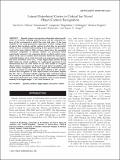Files in this item
Lateral entorhinal cortex is critical for novel object-context recognition
Item metadata
| dc.contributor.author | Wilson, David Ian Greig | |
| dc.contributor.author | Langston, Rosamund F. | |
| dc.contributor.author | Schlesiger, Magdalene I. | |
| dc.contributor.author | Wagner, Monica | |
| dc.contributor.author | Watanabe, Sakurako | |
| dc.contributor.author | Ainge, James Alexander | |
| dc.date.accessioned | 2013-04-03T09:31:01Z | |
| dc.date.available | 2013-04-03T09:31:01Z | |
| dc.date.issued | 2013-02 | |
| dc.identifier | 22162974 | |
| dc.identifier | 0a5d81c5-db49-4ec0-9b9c-32cf54a374a6 | |
| dc.identifier | 84876111383 | |
| dc.identifier | 000317362500004 | |
| dc.identifier.citation | Wilson , D I G , Langston , R F , Schlesiger , M I , Wagner , M , Watanabe , S & Ainge , J A 2013 , ' Lateral entorhinal cortex is critical for novel object-context recognition ' , Hippocampus , vol. 23 , no. 5 , pp. 352-366 . https://doi.org/10.1002/hipo.22095 | en |
| dc.identifier.issn | 1050-9631 | |
| dc.identifier.other | ORCID: /0000-0002-0007-1533/work/60428125 | |
| dc.identifier.uri | https://hdl.handle.net/10023/3459 | |
| dc.description.abstract | Episodic memory incorporates information about specific events or occasions including spatial locations and the contextual features of the environment in which the event took place. It has been modeled in rats using spontaneous exploration of novel configurations of objects, their locations, and the contexts in which they are presented. While we have a detailed understanding of how spatial location is processed in the brain relatively little is known about where the nonspatial contextual components of episodic memory are processed. Initial experiments measured c-fos expression during an object-context recognition (OCR) task to examine which networks within the brain process contextual features of an event. Increased c-fos expression was found in the lateral entorhinal cortex (LEC; a major hippocampal afferent) during OCR relative to control conditions. In a subsequent experiment it was demonstrated that rats with lesions of LEC were unable to recognize object-context associations yet showed normal object recognition and normal context recognition. These data suggest that contextual features of the environment are integrated with object identity in LEC and demonstrate that recognition of such object-context associations requires the LEC. This is consistent with the suggestion that contextual features of an event are processed in LEC and that this information is combined with spatial information from medial entorhinal cortex to form episodic memory in the hippocampus. © 2013 Wiley Periodicals, Inc. | |
| dc.format.extent | 1297794 | |
| dc.language.iso | eng | |
| dc.relation.ispartof | Hippocampus | en |
| dc.subject | Episodic | en |
| dc.subject | Memory | en |
| dc.subject | Hippocampus | en |
| dc.subject | Associative | en |
| dc.subject | Context | en |
| dc.subject | RC0321 Neuroscience. Biological psychiatry. Neuropsychiatry | en |
| dc.subject.lcc | RC0321 | en |
| dc.title | Lateral entorhinal cortex is critical for novel object-context recognition | en |
| dc.type | Journal article | en |
| dc.contributor.sponsor | BBSRC | en |
| dc.contributor.institution | University of St Andrews. School of Psychology and Neuroscience | en |
| dc.contributor.institution | University of St Andrews. Institute of Behavioural and Neural Sciences | en |
| dc.identifier.doi | https://doi.org/10.1002/hipo.22095 | |
| dc.description.status | Peer reviewed | en |
| dc.identifier.grantnumber | BB/I019367/1 | en |
This item appears in the following Collection(s)
Items in the St Andrews Research Repository are protected by copyright, with all rights reserved, unless otherwise indicated.

